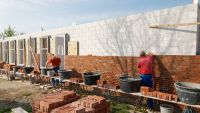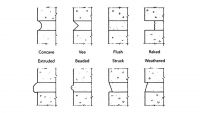Keeping the Coast Guard high and dry
Manganaro Midatlantic provides water-tight exterior for new headquarters building
With a fleet of ships that includes 35 different types of cutters and smaller boats, the U.S. Coast Guard understands the importance of keeping its vessels watertight. A well-built ship or boat enables servicemen and servicewomen to carry out their search-and-rescue operations, patrol missions, and other duties as safely as possible.
Manganaro Midatlantic, a subcontracting firm specialized in quality masonry, drywall and acoustical ceiling work since 1958, believes that the service’s administrative employees, both military and civilian, should enjoy that same assurance regarding their working space. During the construction of the new Coast Guard Headquarters on the historic St. Elizabeth Hospital site in Washington, D.C., the company worked painstakingly to ensure that the vapor barrier and masonry it installed would form a tight, attractive, waterproof shell for the building.
The Coast Guard Headquarters includes an 11-story, 1.2 million-square-foot building, an adjacent parking structure, and a central utility processing building. Its construction is the first phase of a multi-year plan that will consolidate most of the operations of the U.S. Department of Homeland Security onto one campus.
Manganaro Midatlantic performed all of the masonry work on the Coast Guard building, installing 85,000 square feet of bricks, concrete masonry units (CMU), interior block work partitions, and garages. It also was responsible for the application of the air and vapor barrier.
The project was challenging on several levels, according to Jonathan Lane, Manganaro Midatlantic’s senior project manager.
“The blast protection requirements and the configurations of elements such as the windows made the coordination between trades exceptionally difficult,” Lane says. “Many trades, including ours, had to go to the wall two or three times to sequence the work in the proper order, so that we could ensure we were giving the owner a blast-resistant and watertight product.”
To form the building walls, for example, Manganaro’s crews had to fully grout the CMU and then place dowel rebar in every cell. “There’s a massive amount of effort that went into getting the blast-proof skeleton up so that we could put the veneer on,” Lane says.
Before the company could apply the spray-on air and vapor barrier to these walls, it had to carefully prepare the base using blue skin membranes that seal the building in transition areas. These areas include windows, corners and places where the underlying material changed from concrete to gypsum or from concrete to CMU.
“Applying the blue skin on this building was probably the most concentrated amount of detail work that we’ve ever had to do,” says Lane. For the transitions between the window system and the skin, Manganaro Midatlantic coordinated materials with the window contractor to make sure that the products selected by the architect would hold up over time.
“There were instances where certain products couldn’t touch each other; you had to be very conscious of that during the installation,” Lane continues.
Lane also assisted the Clark Construction design/build team in coordinating the use of its scaffolding among all trades, including its own air and vapor barrier and masonry groups.
“This is one example of how Manganaro Midatlantic’s One Voice One Team approach benefits the project owner and the project schedule,” Lane says. “We are able to ensure that we had the air and vapor barrier completed in one area before having the masonry crew move there.”
Another advantage of the One Voice One Team approach is evident in the cooperation among various crews. Although Manganaro’s groups generally are dedicated to one particular trade – masonry, for instance – employees are willing and able to pitch in as needed to help out other facets of the company’s operations.
“The different groups also provide quality control checks for each other’s work,” Lane says. “The air and vapor barrier guys would check the substrate to make sure that it looked right as a quality control measure. Then, before we put the bricks and flashing on, we would make sure that the air and vapor barrier was installed correctly.”
Manganaro Midatlantic has spent two years on the project and has completed it substantially. The construction of the entire Coast Guard Headquarters was completed in Q1 2013, with employees moving into the watertight – and shipshape – building this summer.
Originally published in Masonry magazine.
About the Author
Lindsey Beedle is an account executive for Christie Communications.



















